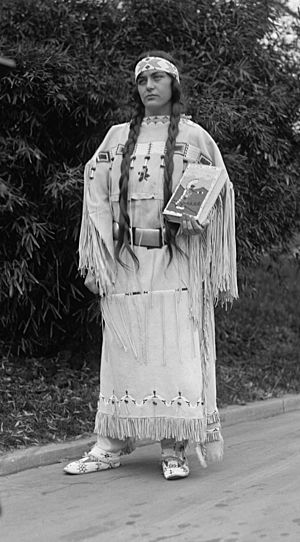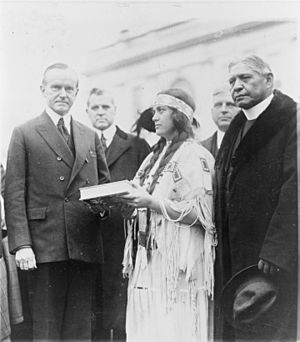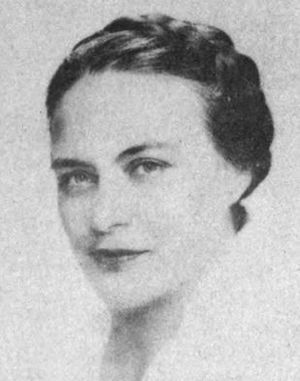Ruth Muskrat Bronson facts for kids
Quick facts for kids
Ruth Muskrat Bronson
|
|
|---|---|

Ruth Muskrat, holding The Red Man In The United States, December 13, 1923
|
|
| Born |
Ruth Margaret Muskrat
October 3, 1897 |
| Died | June 12, 1982 (aged 84) |
| Nationality | American |
| Occupation |
|
| Years active | 1925–82 |
| Known for | first Guidance and Placement Officer of the Bureau of Indian Affairs |
Ruth Muskrat Bronson (born October 3, 1897 – died June 12, 1982) was a Cherokee poet, teacher, and a champion for Native American rights. She worked hard to improve the lives of Indigenous people in the United States.
After finishing her studies, Ruth Bronson became the first Guidance and Placement Officer for the Bureau of Indian Affairs (BIA). The BIA is a U.S. government agency that works with Native American tribes. She later served as a leader for the National Congress of American Indians (NCAI), which started in 1944. She also created their news service to share important updates about laws affecting Native Americans.
After working in Washington, D.C. for ten years, Bronson moved to Arizona. There, she helped with health education for the Indian Health Service. When she retired from government work, she received a special award called the Oveta Culp Hobby Service Award. She continued to fight for Native American rights, helping them grow and lead their own communities until she passed away.
Contents
Early Life and Family Background

Ruth Margaret Muskrat was born on October 3, 1897. Her birthplace was White Water, Oklahoma, on the Delaware Nation Reservation. This area was then known as Indian Territory. Her mother, Ida Lenora, was from Missouri. Her father, James Ezekial Muskrat, was Cherokee.
Ruth's father's family had a difficult history. They were forced to move from Georgia to Indian Territory in the late 1830s. This sad journey is known as the Trail of Tears. It was part of a larger event called Indian removal. When Ruth was ten, she saw how new laws changed her nation. The Curtis Act of 1898 broke up shared tribal lands into smaller pieces. This greatly affected the lives of the Five Civilized Tribes.
Ruth's Early Schooling
When she was fourteen, Ruth Muskrat started high school. She attended a preparatory school at the Oklahoma Institute of Technology in Tonkawa. She finished there in 1916. She then continued her studies at Henry Kendall College in Tulsa. She also went to Northeastern State Teachers College.
Ruth faced money problems, so she had to stop school for a while. She taught for two years to save enough money. This allowed her to go back and continue her education.
College Years and Important Experiences
In 1919, Ruth Muskrat enrolled at the University of Oklahoma. She studied there for three semesters. In the summer of 1921, she worked for the YWCA. This group sent her to help on the Mescalero Apache Reservation in New Mexico.
Her report about her work there earned her a scholarship. This scholarship allowed her to attend the University of Kansas. She studied there for three more semesters.
Advocacy and International Recognition
In 1922, Ruth Muskrat traveled to Peking (now Beijing), China. She was part of a YWCA group attending an international youth conference. She was one of the first Native American women to represent students abroad. Her trip included visits to Hawaii, Japan, and Korea. This journey made her known to people around the world. It also inspired her to work for fairness and equality for all races.
Meeting the President
The next year, Ruth Muskrat spoke to the President of the United States. She asked President Coolidge to provide better schools for Native Americans. She made this speech at a meeting of Native American leaders. This group was called the "Committee of One Hundred." They met to give advice to President Coolidge on policies for American Indians.
Ruth argued that Native Americans should be involved in solving their own problems. Her speech deeply moved President Calvin Coolidge and his wife, Grace. They invited Ruth to have lunch with them.
Finishing Her Education
In 1923, Ruth enrolled as a junior at Mount Holyoke College. She received a full scholarship to attend. In 1925, she graduated with a Bachelor of Arts degree in English. During her college years, Ruth Muskrat wrote many poems. Her writing was influenced by the Modernist movement.
Ruth Bronson's Career and Contributions
After graduating, Ruth Muskrat started working at the Haskell Institute. She taught eighth grade there. Later, she became the head of the college placement office. Ruth was very popular with her students. They loved her sense of humor. She also made sure to share Native American culture with them. She often told her students, "Indians are people too, don't forget that." This reminded them to be proud of their heritage.
In 1926, she won the Henry Morgenthau Prize. This award was for using her college education well in her first year after graduation. Throughout the 1920s, Bronson believed that Native American education should not force them to give up their culture. Instead, it should help preserve "what was best" in Native cultures. In 1925, she wrote a short story called "The Serpent." This story questioned government policies during a time when tribal lands were being divided.
Family Life and New Roles
In 1928, Ruth Muskrat married John F. Bronson. They later adopted a Native American girl.
In 1931, the Bureau of Indian Affairs (BIA) started a new program. Its goal was to improve education for Native Americans. Ruth Bronson was chosen to be the first Guidance and Placement Officer for the BIA. Her job was to help Native American graduates find good jobs. In 1937, she received the Indian Achievement Medal. She was only the second woman to get this award. Bronson was in charge of giving out government loans and scholarships to students. She also helped them find employment. She worked at the BIA until 1943.
Bronson took a few years off from work to raise her daughter. During this time, she wrote and published several books and articles. These included Indians are People Too (1944) and The Church in Indian Life (1945). She also wrote Shall We Repeat Indian History in Alaska? (1947).
Leading the National Congress of American Indians
In 1945, Bronson began working with the National Congress of American Indians (NCAI). This organization had just been formed. She quickly became a leader. She was named the executive secretary of the NCAI. For ten years, she watched over new laws that affected Native Americans. She also started the NCAI's news service for legislative updates.
During this time, she spoke at many tribal meetings across the country. She encouraged progress for Native Americans. Bronson fought for issues like Native water rights along the Colorado River. She also worked for Native rights in the Territory of Alaska. She pushed for better medical care for American Indians. After ten years as executive secretary, Bronson was elected treasurer of the NCAI in 1955. She was tired of national politics. So, she decided to focus on working directly with local communities.
Later Work and Awards
In 1957, Bronson moved to Arizona. She worked as a health education specialist at the San Carlos Apache Indian Reservation. This was for the Indian Health Service. At the same time, she was a vice president for the ARROW Organization. This group helps others through giving. She managed their education loan and scholarship fund. She also advised tribes on how to develop their communities.
In 1962, Bronson received the Oveta Culp Hobby Service Award. This award came from the Department of Health, Education and Welfare. It recognized her important work helping Native Americans. After this, she retired from government service.
She then moved to Tucson, Arizona. In 1963, Bronson became the national program chairman for the American Indian section of the Community Development Foundation. This organization was part of the Save the Children Federation. In 1972, Bronson had a stroke. She slowed down but did not stop her work for Native Americans. She continued to support their right to create their own development and leadership programs. In 1978, Bronson received an award from the National Indian Child Conference. This was for her dedication to improving the lives of children.
Ruth Bronson also changed ideas about gender roles in the Cherokee Nation. She dressed in ways that helped her get into important places. She followed the example of male leaders in her style.
Ruth Muskrat Bronson passed away on June 12, 1982, in Tucson, Arizona.
Images for kids
-
Committee of 100 on Indian Affaires, with President Calvin Coolidge, Ruth Muskrat, and Rev. Sherman Coolidge
See also
 In Spanish: Ruth Muskrat Bronson para niños
In Spanish: Ruth Muskrat Bronson para niños



